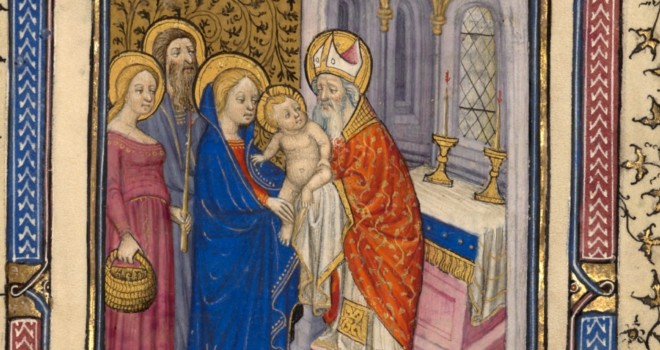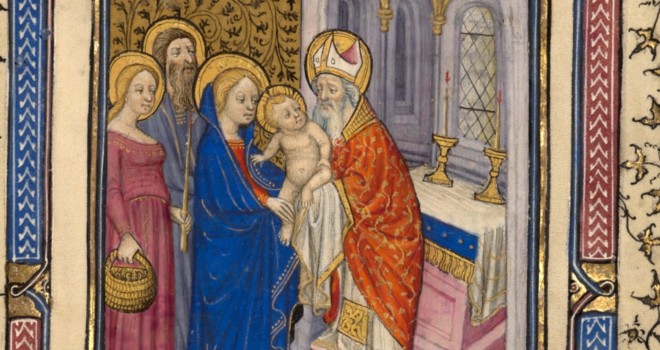As a young mother, holding my first child in my arms, I remember thinking often of Mary going through the various “rites of passage” of her time and faith. When my oldest child was baptized, I was in the early throes of (undiagnosed) postpartum depression (PPD). There was such tremendous comfort and normalcy found in her Baptism. The words were familiar, the rite was familiar, and the priest radiated joy.
This experience of finding consolation as a new mother led to deeper contemplation of Mary’s experience as a new mother. Surely, Mary knew about the custom of presenting a firstborn son in the Temple. She must have been so happy and felt so relieved to have one aspect of her experience, as a new mother, feel normal.
But Jesus’s presentation was not the same as every other little Jewish boy’s, and even that moment was infused with suffering.
The Suffering of a Mother
I am not alone in my experience with postpartum depression. It is a common experience, and I have since talked to many other loving mothers who have faced it. As a new mother, though, I did not have that kind of support system. I was the first of my friends to become a mother, and all that I knew was what I read or was told about new motherhood. Although some experiences were what I expected (my baby was the most beautiful baby in the world and the smell of her soft, downy head made me swoon), other aspects were much harder than I had hoped. I now know that my firstborn was a relatively easy baby, but I was an unexperienced mother whose doctors did not take her symptoms of PPD seriously. This led to suffering in those early months that were not what I had expected. And that suffering often made me feel like a failure.
I know now that I was not a failure. I was a good mother who loved her baby and took good care of her. I was just suffering, for reasons that were not my fault or my baby’s fault.
Mary of the Presentation would be a good patron for any mother facing postpartum depression, anxiety, or OCD (all of which often go misunderstood and misdiagnosed in new mothers).
She surely must have envisioned Jesus’s presentation before that day. So much about her experience of motherhood was nothing like she had imagined. She became a mother in a most extraordinary way. She spent the last days of her pregnancy traveling and gave birth in a stable without her mother or female relatives assisting her. The first visitors were not family and friends doting on her newborn, but a ragtag team of shepherds. As one with total trust in God, Mary took it all in stride.
But even without postpartum depression, Mary was surely feeling the ups and downs of new motherhood. She must have been tired. She must have been unsure. And even though she knew that God would provide, she still must have still had moments of feeling overwhelmed by the sheer magnitude of her new responsibility (she just offered that up to God with more perfect trust than an ordinary mother!). So much had been different than she expected, but the presentation in the Temple…surely that would be like she had imagined. Surely, it would be an experience of joy.
And, at first, it seemed like it would be. Then Simeon showed up. In her graciousness, she received his joy, his eagerness, and his beautiful canticle. In fact, knowing how special her Son was, such an occurrence was probably not unexpected.
But Simeon did not stop there. He looked at her, with deep and serious eyes, and told her those fateful words, “… destined to be a sign that is rejected…” and, “You, yourself, a sword will pierce.”
Surely, a sword pierced her heart at that very moment, as she looked at Jesus’s tiny, fluttery eyelashes, felt his chest rise and fall in sleep, and saw his little rosy cheeks, waiting to be kissed by her lips. As any mother of a newborn can attest—the thought of harm coming to your baby is more than you can bear. Your heart is inextricably woven with the fate of the child in your arms.
At a moment that should have been one of utter joy… even there, Mary found suffering.
Suffering as a Sign of Love
Jesus was not an ordinary baby. He was born to suffer. As God made man, he came to earth to bear the weight of our sins and ultimately to die for us. That was his purpose, right from day one.
In my almost eleven years of motherhood, I have seen my children suffer. I have seen them suffer in little ways—scrapes and scratches and hurt feelings. I have seen them suffer in big ways. I have experienced a child being hospitalized with a serious illness, and during her suffering (and eventual recovery) I found myself unable to leave her alone. Even when I could not be physically present, I was suffering along with her. There is something about the bond between a (healthy and non-abusive) mother and child that makes it impossible for a mother not to suffer with her child.
Suffering is unavoidable in this fallen world of ours. It was especially unavoidable for Jesus, who had come for that very purpose. So, was Mary’s suffering a sign of her failure as a mother? On the contrary, her suffering was indicative of her deep love for her Son.
In a world that preaches the prosperity Gospel and the “power of positive thinking,” we often forget that the real Gospel is about neither. It is about taking up our cross, in love, and suffering for the sake of that love. It is about following the example of Mary and her Son.
Surely, Mary was offered platitudes from well-meaning bystanders. But the source of her peace was that deep love, a love that was honed and strengthened by suffering. Her Son suffered for love of her (applying the grace of his death to her sanctification before the fact). And, since her heart was conformed to his, she suffered for love of him.
Suffering is not a sign of failure. In fact, when embraced with love, it can be a sign of a vocation lived well.
(If you or a loved one is facing post-partum depression or any other mental health difficulty, I encourage you to check out our relevant articles for some great resources and guidance for next steps. Embracing suffering does not mean not experiencing healing, and God certainly works through medical professionals!)
✠
image: The Presentation in the Temple, illuminated manuscript by Follower of the Egerton Master (French / Netherlandish, active about 1405 – 1420) / The J. Paul Getty Museum, Los Angeles, Ms. Ludwig IX 5, fol. 69 / Digital image courtesy of the Getty’s Open Content Program.













